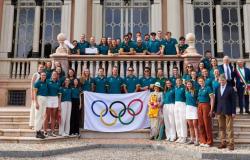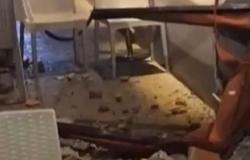June 5, 2024 will be a date that employees of Boeing, United Launch Alliance (ULA), and NASA will remember with pleasure and relief. In the Italian afternoon, more precisely at 4.52pm, the Atlas V N22 took off from Space Launch Complex 41 in Cape Canaveral, Florida, headed towards the International Space Station (ISS): the CST-100 Calypso capsule was mounted on the top of the rocket , and inside were commander Barry Wilmore and pilot Sunita Williams, both members of the astronaut corps of the US space agency (NASA).
Docking is scheduled for 6.15pm Italian time at the ISS, where it should remain for a few weeks: at the end of its stay in orbit it will land in the New Mexico desert, where some recovery teams will extract and visit the astronauts, as well as any experiments. The capsule will then be transported to Boeing facilities for post-flight analyses, which will allow it to enter regular service for the transport of astronauts.
The latest communications between the crew and the control center reported that the astronauts woke up around 10.30 am Italian time and were updated on some helium leaks from the pressurization circuit of the Reaction Control System (RCS): some were already known before take-off, so much so that they were the cause of one of last month’s postponements, while others were identified afterwards. However, these are minimal losses that will not prevent docking to the International Space Station: technicians are already working to mitigate the situation.
The flight comes after years of waiting and numerous postponements, during which Boeing tried to correct errors, modify procedures and implement requests that came from time to time from the various authorities in charge.
CST-100, acronym for Crew Space Transportation, was in fact a capsule with a rather troubled history: the first test flight, carried out without a crew (OFT-1), dates back to December 2019, when the same capsule that left yesterday was launched towards the ISS. The absence of people on board is part of the standard procedure for certification of the capsule: all the procedures carried out before, after and during the launch, the performance in orbit and the behavior of the capsule upon return to Earth must be verified. However, on board there were some anthropomorphic mannequins equipped with various sensors to collect data on acceleration, temperature, pressure, carbon dioxide concentration, as well as some supplies, spare parts or scientific experiments to bring on board the Station. Usually the stay in orbit is short, about a week, and is followed by an in-depth analysis of the data collected, even during the re-entry phase, and a possible correction of systems or components that have not performed as expected.

If all the values fall within the simulations and safety parameters imposed by NASA, after a few months the crewed mission is carried out: once again it is a test mission, carried out with two expert astronauts who will have the task to verify the safety of the capsule, as well as the various procedures. Once docked to the ISS the nominal duration is approximately two weeks, during which the two astronauts join those already in orbit to conduct scientific experiments, extra-vehicular activities (EVA) or public relations events. If the capsule performs well and the organization of life on board allows it, it is possible to extend the stay by several weeks: this is what happened to Doug Hurley and Bob Behnken, the two test astronauts of SpaceX’s Crew Dragon capsule , who stayed on the ISS from the end of May to the beginning of August 2020.
Both Dragon and CST-100 are in fact the two astronaut transport systems chosen by NASA to regain independent access to the Space Station, lost after the withdrawal of the Space Shuttle in 2011, and only possible via the Soyuz capsule of Roskosmos, the agency Russian spacecraft. In a context in which the private aerospace sector was growing more and more and building on the results obtained by the Commercial Resupply Services (CRS), NASA decided to entrust the design, construction, development and management of a capsule for the transport of astronauts to private individuals, providing some guidelines and safety standards, in addition to its own experience in the field.
However, only the Crew Dragon entered stable service: after the uncrewed (DM-1, March 2019) and crewed (DM-2, May-August 2020) test mission, 8 long-duration missions followed towards the ISS, each lasting approximately six months, as well as three missions on behalf of the space tourism company Axiom, again to the ISS, and one free flight as part of the charity initiative Inspiration4 by Jared Isaacman. Isaacman himself also announced the program Polariswhich among other things will see a Dragon capsule engaged as the scene of an extravehicular activity.
It can therefore be seen that the delay accumulated between the first test flight of CST-100 and the first manned one is significant and representative of the problems experienced over the years. Already on the occasion of OFT-1, serious problems occurred relating to the internal clock of the capsule, which was out of phase with respect to the actual timeline of the mission and therefore commanded the ignition of the maneuvering thrusters in an incorrect flight phase. As a consequence, the fuel to carry out the docking maneuvers towards the Space Station was insufficient and CST-100 carried out only a part of all the planned checks. But before we get to this flight, also known as Crew Flight TestBoeing decided to carry out another one at its own expense Orbital Flight Testto verify that everything was working correctly: however, valve problems had forced the company to postpone the flight until May 2022. From that moment on, defects in the parachutes, helium control valves and other factors prevented the first manned mission from taking place.
The Starliner delays not only affected Boeing’s image and finances, but also the astronauts. Nicole Mann and Josh Cassada had in fact been assigned as pilots of the Crew Flight Test and Starliner-1, respectively, while Jeanette Epps had trained on the systems of both capsules: all three were then assigned to Dragon missions, in particular Crew-5 (October 2022 – March 2023) for the first two and Crew -8 (March 2024) for Epps.
![]() This article is copyright of the ISAA Association 2006-2024, unless otherwise indicated. – Consult the license. Our license does not apply to any third party content in this article, which remains subject to the terms of the respective rights holder.
This article is copyright of the ISAA Association 2006-2024, unless otherwise indicated. – Consult the license. Our license does not apply to any third party content in this article, which remains subject to the terms of the respective rights holder.








